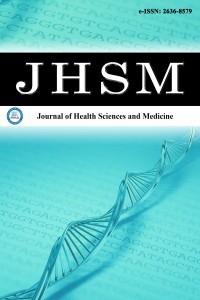
Journal of Health Sciences and Medicine
Yazarlar: Erdal DİLEKÇİ, Esra Nur ADEMOĞLU DİLEKÇİ
Konular:Sağlık Bilimleri ve Hizmetleri
DOI:10.32322/jhsm.776446
Anahtar Kelimeler:Osteoporosis,Uric acid,Bone mineral density,Postmenopausal women
Özet: Objectives: Osteoporosis is an important public health problem which is characterized by loss of bone mass resulting in susceptibility to fractures. There is much evidence indicating that uric acid, a final enzymatic product of purine metabolism, has beneficial antioxidant effects on several chronic diseases such as diabetes mellitus, hypertension and cardiovascular diseases. We aimed to evaluate the relationship between serum uric acid levels and bone mineral density (BMD) on postmenopausal osteoporosis in the present study. Material and Method: This study was carried out at the Bolu İzzet Baysal Physical Medicine and Rehabilitation Training and Research Hospital, Department of Physical Medicine and Rehabilitation.. The medical records of 1200 postmenopausal women between January 2019 and 2020 who had dual energy x-ray absorptiometry (DEXA) examination and serum uric acid levels recorded were screened retrospectively. In total, 92 individuals with osteoporosis and 399 healthy individuals were included in the study after exclusion of subjects with systemic diseases or taking drugs affecting bone metabolism or uric acid levels. Bone mineral density and T scores of femur neck (F neck) and lumbar spine (L2-L4), glucose, AST, ALT, creatinine, alkaline phosphatase, calcium, phosphate, parathormone (PTH), albumin and total protein were all recorded in individuals. Results: Serum uric acid concentrations were found to be significantly lower in the osteoporosis group compared with the control group [4.65(2.40-7.80) vs 5.20 (3.80-9.40); p<0.001, respectively]. In correlation analysis, uric acid was significantly associated with fasting blood glucose (r=0.129, p=0.004), creatinine (r=0.374, p<0.001), calcium (r=0.201, p<0.001), total protein (r=0.123, p=0.006) and TSH (r=0.108, p=0.017). Correlation analysis also revealed a significant and positive correlation between uric acid and L2-L4 BMD (r=0.255, p<0.001). L2-L4 BMD was found to be independently related with uric acid in multivariate linear regression analysis after adjustment for confounding factors (B=1.619, p<0.001). Conclusion: Our findings revealed that serum uric acid levels and lumbar (L2-L4) BMD were independently associated with each other in postmenopausal osteoporosis. Further studies are needed to determine the association of uric acid with osteoporosis and to address the utility of uric acid in clinical practice.